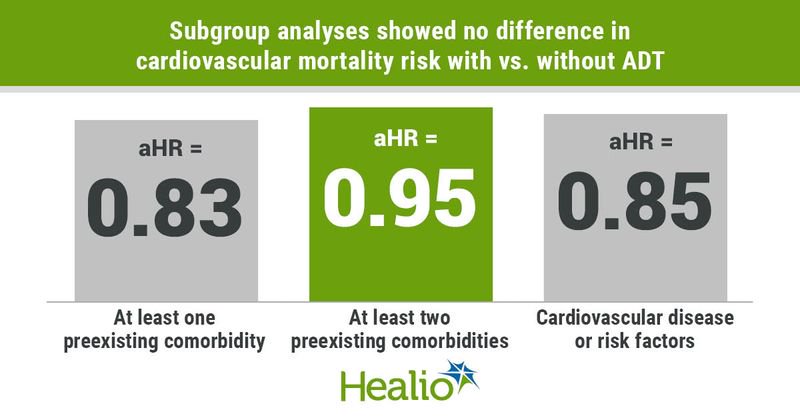ADT not associated with increased risk for cardiovascular mortality in prostate cancer
The addition of androgen deprivation therapy to radiation therapy did not appear associated with an increased risk for cardiovascular mortality among men with prostate cancer, according to a study published in Cancer.
The lack of an association extended to subgroups of men with preexisting comorbidities and cardiovascular disease in the secondary analysis of the randomized PLCO (prostate, lung, colorectal and ovarian) Cancer Screening Trial.

“We were motivated to study the association between ADT and cardiovascular mortality [because] prior studies have suggested that ADT may increase the risk [for] cardiovascular morbidity and mortality but, in general, these studies either did not have detailed comorbidity information or did not have large sample sizes,” Vinayak Muralidhar, MDMSc, clinical fellow in medicine in the department of radiation oncology at Mass General Cancer Center and Harvard Medical School, told Healio. “Because the effect of ADT on cardiovascular mortality may depend on underlying cardiovascular comorbidity, we wanted to examine this association in subgroups of patients who had preexisting comorbidities.”
The analysis included 1,463 men (median age, 65 years; range, 55-74) diagnosed between 1993 and 2001 with clinically localized, immediate-risk (69.2%) or high-risk (30.8%) prostate cancer, defined as clinical T2b to T4, Gleason score of 7 to 10 or PSA greater than 10 ng/mL.
The majority of men (52.8%) had a history of at least one preexisting comorbidity, whereas 17.2% had at least two preexisting comorbidities, and 60.2% had either a history of cardiovascular disease or risk factors.
Among all of the men, 565 (94.3% “non-Black”) received radiation therapy alone and 898 (93% “non-Black”) received radiation therapy plus ADT.
Researchers used Fine and Gray competing-risk regression analysis to determine adjusted HRs, stratified by comorbidity history, for cause-specific mortality. They classified causes of death as prostate cancer‐specific mortality vs. other‐cause mortality, including the primary endpoint of cardiovascular mortality (ischemic heart disease, cerebrovascular accident or other circulatory disease as cause of death).
Muralidhar and colleagues measured survival from the time from prostate cancer diagnosis to death of any cause or loss to follow-up. Median follow-up was 66 months (range, 31-103).
Results showed no difference in risk for 5‐year cardiovascular mortality between men who received ADT plus radiation therapy and those who radiation therapy alone (2.3% vs. 3.3%; adjusted HR [aHR] = 0.69; 95% CI, 0.38‐1.24).
Subgroup analyses also showed no difference in cardiovascular mortality risk with vs. without ADT among men with a history of at least one preexisting comorbidity (3.2% vs. 5.3%; aHR = 0.83; 95% CI, 0.43‐1.6), at least two preexisting comorbidities (6.9% vs. 8.3%; aHR = 0.95; 95% CI, 0.4‐2.25), or cardiovascular disease or risk factors (3.6% vs. 4.3%; aHR = 0.85; 95% CI, 0.44‐1.65).

“We genuinely did not know what we would find when we began the study,” Muralidhar said. “Based on the significant data suggesting an association between comorbidity and cardiovascular morbidity following ADT, we had expected to see an association between ADT and cardiovascular mortality in the subgroup of patients with preexisting cardiac comorbidities, so it was a little surprising that we did not detect such an effect.”
When Muralidhar and colleagues analyzed each component of cardiovascular mortality separately — either cardiac, stroke or other vascular mortality — they observed similar results.
“The decision to use ADT and the duration of ADT remain complex, and I hope that our data are at least somewhat reassuring that ADT — which is a very important piece of prostate cancer treatment — can be safe in patients from a cardiovascular perspective, even if there is preexisting cardiac morbidity,” Muralidhar said.
Researchers noted that possible adverse effects of ADT, along with the high risk for other-cause mortality, still should be weighed against the possible cancer-specific mortality benefit for each patient.
“Future studies are needed to better understand how ADT, and many other cancer-directed therapies in general, affect cardiovascular outcomes,” Muralidhar said. “More prospective studies are needed with careful capturing of preexisting comorbidities, and future studies of systemic therapies for localized prostate cancer should seek to stratify or prespecify hypotheses based on comorbidity status.”
For more information:
Vinayak Muralidhar, MD, MSc, can be reached at Department of Radiation Oncology, Brigham and Women's Hospital, 75 Francis St., Boston, MA 02115; email: vmuralidhar@bwh.harvard.edu.

